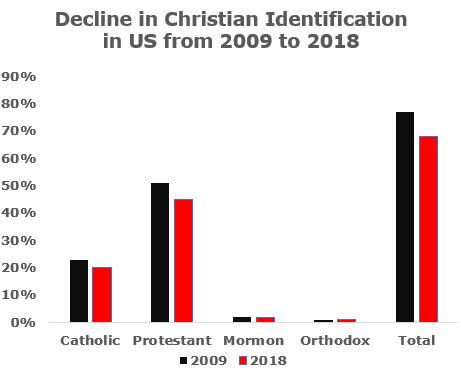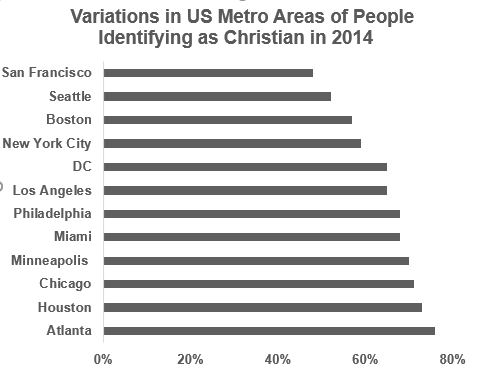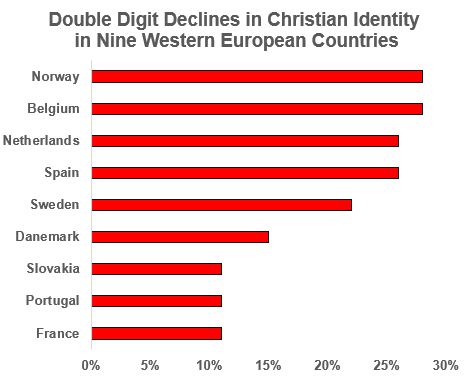MIAMI (The Wild Hunt) — For years now, Christianity has had declining membership and influence in the “West.” At the same time, Paganism has been growing. Nietzsche may have made his claim that “God is dead” 100 years too early. The revival of Pagan practices may be one of its consequences.
The Pew Research Center (PRC) has as one of its core areas of interest, “Religion and Public Life.” It provides extensive reportage on this decline in Christian identity. The PRC has also begun to report on Pagan identity. It describes itself as a “nonpartisan fact tank,” using public opinion polling, and demographic research.
Estimating the number of Pagans in the US
Paganism remains a small, but growing, minority religious movement. The 2014 Pew Institute Religious Landscape Study reported that 0.03 percent of respondents in the US identified as either Pagan or Wiccan. In the US, the Pagan population is about the size of a small Protestant denomination. For example, less than 0.3 percent of respondents identified as Quakers. About 0.5 percent of respondents identified as Congregationalists.
The larger mainline Protestant denominations ranged from Episcopalians with 1.2 percent of respondents to Baptists with 2.1 percent of respondents.
About 2.1 percent of respondents identified as Jewish. About 20.8 percent of respondents identified as Catholic. Atheists made up 3.1 percent of respondents. Muslims constituted 0.9 percent of respondents.
The American Religious identification Survey of 2012 (ARIS) had similar results. Results from that survey appear in Table 75 of the 2012 Statistical Abstract of the US. About 340,000 people identified as Pagans in 2008. Another 342,000 identified as Wiccans. In contrast, 339,000 identified as Christian Scientists. The combined number of Pagans and Wiccans equaled 682,000.

[data source: The American Religious identification Survey of 2012 – chart by McShee]
Does the number of Pagans and Wiccans exceed the number of Episcopalians or Presbyterians?
Some recent reports have claimed that in the US, Pagans now outnumber Episcopalians or Presbyterians. Most of these reports trace back to an October 4, 2018 report in Quartzy. Several of the sources making this claim were right-wing Christian websites. That Quartzy report referred to an unspecified 2014 study by the Pew Research Center. The Quartzy report said that “0.4% of Americans, or around 1 to 1.5 million people, identify as Wicca or Pagan.” The Quartzy report lacked any estimates for the number of Episcopalians or Presbyterians. It made no comparisons between these denominations and Pagans. It is unclear what Quartzy used as a base number for their interpolation to arrive at the 1 to 1.5 million estimate.
Quartzy failed to respond to requests for clarification by press time. The Pew Research Center did respond by press time. They identified their Religious Landscape Study as the most likely source. Examination of that report does not support those claims.
The Religious Landscape Study reported the percentages of respondents that identified with a religious tradition. It did not estimate that numerical size of any tradition in the US.
According to this Pew Religious Landscape Study, 0.3 percent of respondents identified as Pagans or Wiccans. About 1.4 percent of respondents identified as Presbyterians. About 1.2 percent of respondents identified as Episcopalians. The numbers of Presbyterians and Episcopalians were at least four times as larger than the number of Pagans.
The decline of Christian identification in the US
The Pew Religion and Public Life Center examined the decline in Christian beliefs in the US. The number of people identifying as Christian dropped from 77 percent in 2009 to 67 percent in 2018. The percent of Protestants dropped by about 6 percentage points. The percent of Catholics dropped by about 3 percent. This decrease occurred despite the large migration from heavily Catholic Latin America during this period. This decline occurred among all age, racial, and gender groupings.

[data source: http://www.pewforum.org/2018/07/05/how-does-pew-research-center-measure-the-religious-composition-of-the-u-s-answers-to-frequently-asked-questions/]

[data source: http://www.pewforum.org/religious-landscape-study/ chart by McShee]
Decline of Christian identification in Western, but not Eastern Europe
A Pew Religion and Public Life Center study compared Christian religious beliefs in Eastern and Western Europe. In Western Europe those beliefs have declined. In Eastern Europe, no large decline has occurred. This study included neither Iceland nor Greenland.
It compared those currently identifying as Christian with those raised as Christian. In nine Western European countries, Christian identification dropped by over 10 percentage points. In the Czech Republic, Finland, Germany, Ireland, Italy, Austria, Switzerland, and the United Kingdom, that number dropped between 5 and 9 percentage points. The Netherlands and the Czech Republic no longer have Christian majorities.

[data source: http://www.pewforum.org/2018/10/29/eastern-and-western-europeans-differ-on-importance-of-religion-views-of-minorities-and-key-social-issues/ chart by McShee]
The report aligns with other reports of declining church attendance and power in Western Europe. The Irish votes to accept same sex marriage and abortion may be the clearest indicator of this trend.
The decline in Christian belief in the “West” and the Pagan revival both have occurred over a fifty year period. They indicate profound spiritual shifts in this one part of the world. The presence of Pagan and Wiccan data in Pew Research Center reports shows that the Pagan revival has gained a foothold in the religious landscape of the US.
The Wild Hunt is not responsible for links to external content.
To join a conversation on this post:
Visit our The Wild Hunt subreddit! Point your favorite browser to https://www.reddit.com/r/The_Wild_Hunt_News/, then click “JOIN”. Make sure to click the bell, too, to be notified of new articles posted to our subreddit.